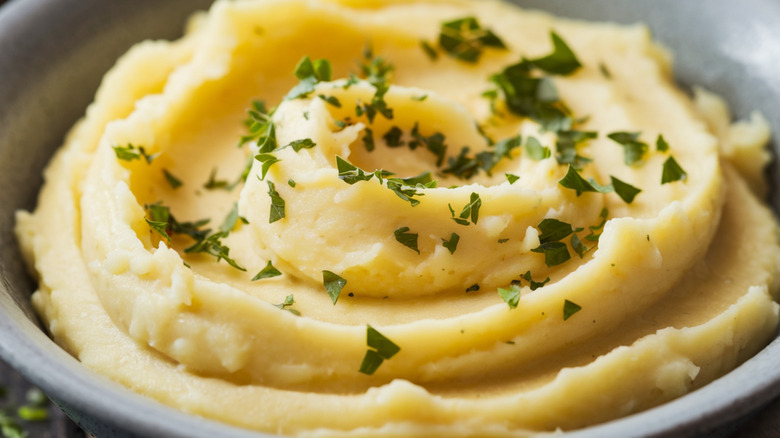The Best Ways To Prevent Mashed Potatoes From Becoming A Gluey Mess
Mashed potatoes, that humble but hearty side dish for many an all-American meal, are textbook comfort food, thanks to the abundant warmth, creamy texture, and rich foundation of salt and butter (and milk, if you choose to go that route, though whipped cream can also get you to fluffy mashed potatoes). However, it takes very little effort to turn mashed potatoes into a sticky, gluey side dish of sadness. To avoid that potato pitfall, The Takeout spoke with chef Jeremy Ford, who recently opened the restaurant Salt + Ash in the Florida Keys. He revealed that there are three ways to keep your mashed potatoes from turning into a grade school adhesive.
As is often the case with your favorite recipes, science contributes to mashed potatoes' consistency. "Mashed potatoes turn gluey when the starch granules inside the potato get over-worked," Ford tells us. "The moment you aggressively mix, blend, or process potatoes — especially in a food processor — you rupture those starch cells and the texture goes straight from silky to gummy." So the first secret for delicious mashed potatoes is to apply the kid glove approach: "At Salt + Ash, where the open fire is our signature, we treat potatoes almost like a protein: with restraint and a little respect," Ford explains.
That means folding the mashed potatoes, not over-mixing, and employing a less aggressive kitchen tool. "A ricer or food mill keeps the starch intact and guarantees that light, restaurant-level texture," says Ford. But you can also stave off that gluey texture even before it comes to the mashing part.
Pick the right potatoes and add fat
One of the best ways to make mashed potatoes is also the most logical: Choose the right potatoes. Jeremy Ford has his druthers: "High-starch varieties like russets make the fluffiest mash," he notes. Waxy potatoes like red potatoes or fingerlings, while the best choice for holding their shape in soup, yield sticky mashed potatoes. Once you've boiled your russets, let them dry. "After boiling, we always steam-dry the potatoes in the pot. Excess moisture makes the starch tighter and the mash heavier," explains Ford.
Butter is another key player in the best mashed potatoes. "Fat acts like a buffer that coats the starch granules and keeps the mash supple," Ford says. "Add your fat first, right after ricing the potatoes while they're still hot. Warm fat absorbs evenly and prevents the potatoes from tightening up."
And what to do if you end up with a pot of potatoes that's better for hanging wallpaper than adding to your holiday menu? Ford has a few saves up his sleeve. Blend your batch with another root vegetable, like parsnips or celery root, to lend smoothness to the texture. Roasted garlic will also come to the rescue, though you can employ crème fraîche or a fire-infused oil; as Ford explains, "These expand the flavor and soften the perception of gumminess." Or transform your gluey batch into a different, delicious side dish. "Turn it into a puree or velouté-style dish," says Ford. "Loosen it with warm stock or milk, run it gently through a fine sieve, and serve it as a silky base under braised meats or charred vegetables." There's no reason to settle for gluey mashed potatoes; Timing, fats, and the right spuds can save the day.

